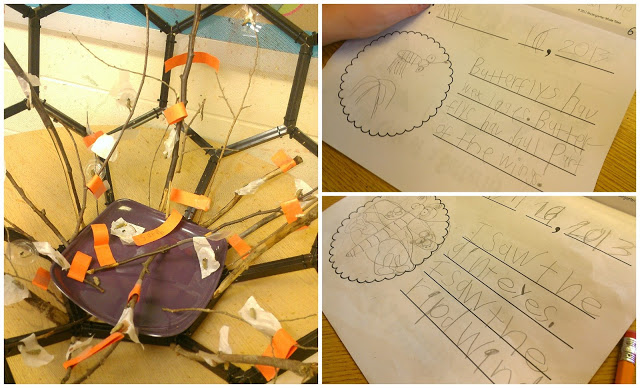Investigating Painted Lady Butterflies in Kindergarten
Here is the next step in investigating painted lady butterflies in kindergarten. I previously laid out how I like to order the larva and my tips for making the process go smoothly. Since it’s one of my favorite things I do in a year, I want to be sure to do it justice in this three part series.
Investigating Painted Lady Butterflies in Kindergarten
This is science that we do in place of our science curriculum since I find ours rather lifeless. This is the opposite and really draws the best out of my readers and writers. Here are my tips on leading some investigations after your larva have arrived.
Be sure to read: Ordering and setting this unit up

Investigating the larva or caterpillars of a Painted Lady butterfly really only takes two things in my opinion. That would be time and magnifying glasses.
It works out great to show them when they first arrive and hold up the travel container for students to observe from afar their general size. Then, I think if you can plan at least 2 times for students to manipulate {gently} and observe up close is right about perfect.
Two times is about all we seem to manage between the time they grow big enough and before they need to be transferred.

Students generally do two writing pieces since they are much more apt to notice body features the second time.
I also will model a guided drawing the second time and we will place the larva under our new document camera.
We use the freeze button so students can come up and point out specific features. The guided drawing gives them the proper tools to show what they see and it helps get rid of smiling Very Hungry Caterpillar-types of drawings. {oh yes, we get those}
Do I tell them what kind they are yet? Nope!
We keep track of specific body features and they keep getting referred to our large section of butterfly books for reference to use what they’ve learned.
You may also like this free teacher resource to teach butterflies in kindergarten as you watch them.
Transferring the Painted Lady Larva
On the second observation, our intention is to also give them food and create an individual habitat for each larva. We have little condiment cups which we purchase with our larva. I model spreading food around the wall of the cup (also ordered) with a window so we can still watch the metamorphosis.

My kinders love creating their own habitats and they also label a card with their name and they name their larva. They keep them along a shelf (out of the sun) as we watch them grow.
Transferring the Pupas (Chrysalises)
We are pretty convinced by this point (and normally confirm it with any books we have) that they indeed will be Painted Lady butterflies and begin transferring them to their new habitat. We use a butterfly net and sticks to create a home for them.

We usually label the sticks or chrysalises in some way this so that we can track who emerges when.
Comparing the Larva and Pupas
This is usually a separate lesson after we’ve transferred our chrysalises and had a chance to look at them very closely! We also try to determine what kind they are by comparing these caterpillar photos and entering in the information we determine is most important when observing our caterpillars. Check out this caterpillar website as a great activity to do with your kinders on a large screen.
To generate a good comparison set for use with Painted Ladies – use:
- Color: black
- Body: spotted
- Hair: sparse
- Distinct Features: spines
It generates only 5 matches to compare and Painted Ladies are the last entry).
Once we do that, I pull up some google images of a painted lady chrysalis to compare it with our investigations. We do that to see if our narrowed down guess holds water when we compare the next portion of the life cycle.
If your class has themselves convinced they are another kind, you can always use this to your advantage to prove/disprove by comparing: A video to watch at least twice and generate some great discussion.
We always discuss:
- the chrysalis’ transparency
- silk attachment to a branch
- antenna imprint in visible in the chrysalis
- where the head is located on the caterpillar when they are about to form the chrysalis
What tips do you have for investigating butterflies in the classroom?
If you like what I do here on KindergartenWorks, then be sure to subscribe today. I look forward to sharing ideas with you weekly.









Hi. I love the way you’ve laid out this butterfly unit! De you have a copy of the writing page shown in the pics? I can’t seem to find it. Thanks!
Hi Zenita,
Yes – you can get it here: https://www.teacherspayteachers.com/Product/Butterfly-Life-Cycle-Observation-Book-130025.
Thanks,
Leslie